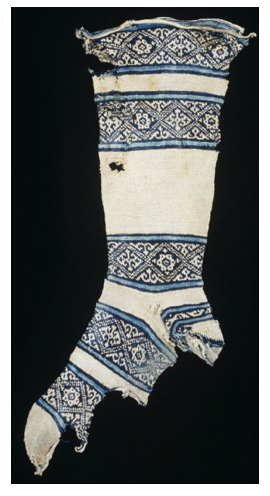File:Islamic sock.jpg
Islamic_sock.jpg (270 × 496 pixels, file size: 126 KB, MIME type: image/jpeg)
12th century sock possibly found in Fustat, Egypt
The knitter of this sock started work at the toe and then worked up towards the leg. The heel was made last and then attached to loops formed while knitting the leg. This ingenious practice allowed the heel to be replaced when it wore out without the necessity of making new socks. The sock is thought to have been made in India because it was found with other materials exported from India and sold in the Egyptian market.
Indigo dyes most likely color the two rich blue cotton yarns used to make the pattern on the socks. The yarn would have been dipped into indigo dye repeatedly until the desired shade was achieved.
Cotton, knitting -- Dimensions 52 cm x 20 cm
The Textile Museum 73.698 -- Acquired by George Hewitt Myers in 1953
| This image is in the public domain because under the Copyright law of the United States, originality of expression is necessary for copyright protection, and a mere photograph of an out-of-copyright two-dimensional work may not be protected under American copyright law. The official position of the Wikimedia Foundation is that all reproductions of public domain works should be considered to be in the public domain regardless of their country of origin (even in countries where mere labor is enough to make a reproduction eligible for protection). | ||||
| ||||
 | This file is a candidate to be copied to Wikimedia Commons.
Any user may perform this transfer; refer to Wikipedia:Moving files to Commons for details. If this file has problems with attribution, copyright, or is otherwise ineligible for Commons, then remove this tag and DO NOT transfer it; repeat violators may be blocked from editing. Other Instructions
| ||
| |||
File history
Click on a date/time to view the file as it appeared at that time.
| Date/Time | Thumbnail | Dimensions | User | Comment | |
|---|---|---|---|---|---|
| current | 19:12, 26 December 2008 |  | 270 × 496 (126 KB) | Tillman (talk | contribs) | 12th century sock possibly found in Fustat, Egypt The knitter of this sock started work at the toe and then worked up towards the leg. The heel was made last and then attached to loops formed while knitting the leg. This ingenious practice allowed the he |
You cannot overwrite this file.
File usage
The following 6 pages use this file:

